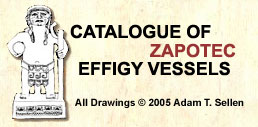| Key: EMB 11152 |
| Actual Location: Ethnographic Museum (Ethnologisches Museum), Berlin, Germany. |
| Collection: Edward Seler 1890 |
| Registration: IV Ca. 11152 |
| Provenance: Tlacolula, Oaxaca |
| Measurements: 26 x 15.5 - 9.3 cm. |
| Color: Grey clay |
| Chronology: Xoo 600 - 800 AD |
| Click to view Chronology |
| Reference: Lehmann 1922, plate 31; Schuler-Schömig 1970: 136, plate 206. |
| Comments: This head fragment has several glyphs in the headdress, including the glyph for hill. The human figure is wearing a nose ring and his teeth have been polished. |
| Glyphs: Above the forehead, the glyph for hill. The face in the headdress, with vertical lines crossing over the eyes, corresponds to glyph P, which seems to be superimposed on a glyph C. In the upper part of the corpus, a glyph N but without |
| Dating: TL by Goedicke et al. 1992, test No. 206: authentic (TL's date: A.C. 1058-1163). |
|
